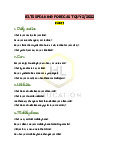

Preview text:
SESSION 2 – Summary Statistics (Central tendency) Single variable data - Scalar – a number -
2-dimensional vector (bivariate data) – a couple of two numbers
Four Ways to Describe Data Sets
When you compare two or more data sets, focus on four features:
Center. Graphically, the center of a distribution is the point where
about half of the observations are on either side.
Spread. The spread of a distribution refers to the variability of the
data. If the observations cover a wide range, the spread is larger. If
the observations are clustered around a single value, the spread is smaller.
Shape. The shape of a distribution is described
by symmetry, skewness, number of peaks, etc.
Unusual features. Unusual features refer to gaps (areas of the
distribution where there are no observations) and outliers.
Should mention Maximum and Minimum
Group 1 also mentioned: Frequency of variables
Summary statistics for variability
Range – maximum of dataset minus minimum of dataset
Mean Absolute Deviation – average of deviation Standard deviation Variance
We have learnt the majority of the important statistics terms




